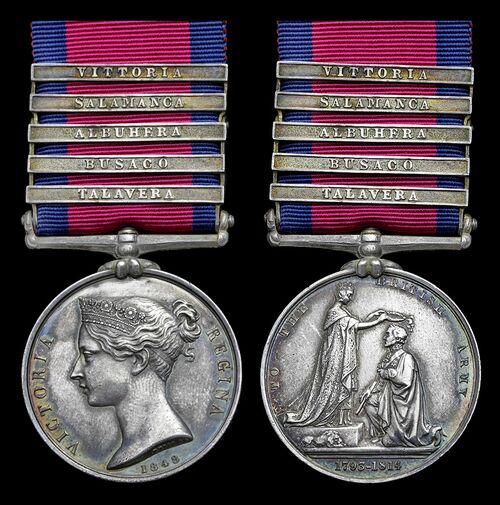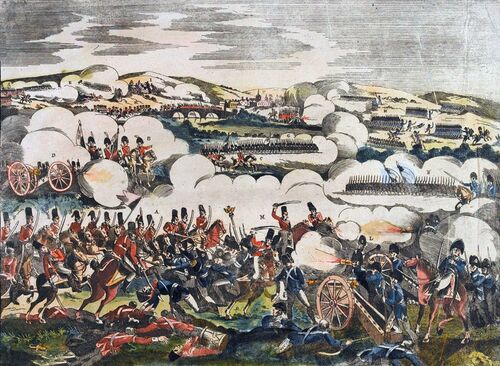Auction: 24002 - Orders, Decorations and Medals
Lot: 28
Military General Service 1793-1814, 5 clasps, Talavera, Busaco, Albuhera, Salamanca, Vittoria (Thos Dunn, 4th Lt Dragns), about extremely fine
Thomas Dunn was born circa 1781 in Lutley, Worcestershire and enlisted with the 4th Dragoons at Birmingham in 1800. They arrived at Lisbon for the Peninsular campaign in 1809 and joined Brigadier General Fane's Heavy Cavalry Brigade together with the 3rd Dragoon Guards. At the Battle of Talavera in July 1809, they supported the charge of the 23rd Light Dragoon Guards and were later present for but kept in reserve at the Battle of Busaco, under the new command of Lieutenant-General De Grey. At the Battle of Albuera on 16 May 1811, the cavalry were controlled by General Lumley who ordered the unit to defend the Albuera Bridge. Lumley commanded the cavalry again at the Battle of Usagre later that month where he pursued General Soult's troops, who sent cavalry to attack the British. Lumley concealed them together with the 3rd Dragoon Guards, allowing them to charge only once the French had already crossed the river. The Regiment lost no men in this event, while the French suffered 250 men killed or wounded.
They participated in one of the most famous cavalry charges of the war at the Battle of Salamanca in July 1812, and there they formed part of Major-General Le Marchant's Heavy Brigade alongside the 3rd and 5th Dragoon Guards. The Heavy Brigade charged the weakened left flank of the French army, in the end destroying eight infantry battalions with sabres designed by Le Marchant himself. Unfortunately the Major-General was shot and killed during his finest moment, and William Ponsonby succeeded to command of the Brigade. While the Regiment played a major role in Salamanca, they were not engaged in the action at the Battle of Vittoria the following year and returned home from Calais in July 1814.
Dunn was discharged at Canterbury in 1821 due to 'being worn out from length of service', which amounted to over 21 years. According to 1841 and 1851 census records, Dunn was living in Brighton with his wife and children. However, the 1861 census reveals an unfortunate turn of fate in Dunn's life, as at age 82 he was living at Brighton workhouse as a pauper and died there on 6 December 1863; sold together with copied research.
Subject to 20% VAT on Buyer’s Premium. For more information please view Terms and Conditions for Buyers.
Sold for
£1,500
Starting price
£800







